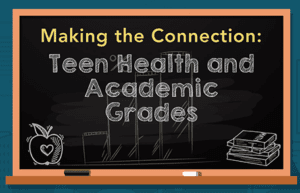 Among U.S. high school students, health risk behaviors—specifically those related to substance use, sexual risk, violence and suicide—are linked to lower academic grades.
Among U.S. high school students, health risk behaviors—specifically those related to substance use, sexual risk, violence and suicide—are linked to lower academic grades.
The academic success of America’s youth is linked strongly with their overall health, and is one way to predict adult health outcomes.
Parents, schools, and communities are key sources of support in helping teens establish healthy behaviors now and as they transition into adulthood.
Healthy Students are Better Learners
Data from the 2015 National Youth Risk Behavior Survey (YRBS) show that students with higher grades are less likely than their peers with lower grades to participate in certain risk behaviors.
Compared to students with lower grades, students with higher grades are
- Less likely to be currently sexually active
- Less likely to drink alcohol before the age of 13
- Less likely to have ever used marijuana
- Less likely to be involved in a physical fight
- Less likely to currently use electronic vapor products
- More likely to engage in physical activity for at least 60 minutes per day on at least 5 days
Addressing risk behaviors in school settings provides an opportunity for improving student health and supporting overarching school goals regarding academic outcomes.
 More than 16.5 million youth in the U.S. are enrolled in school. Schools provide the physical and social environments where youth spend much of their day.
More than 16.5 million youth in the U.S. are enrolled in school. Schools provide the physical and social environments where youth spend much of their day.
Schools are the Right Place for a Healthy Start
Schools play a critical role in promoting the health and safety of young people and helping them establish lifelong healthy behaviors.
School environments that are safe and supportive for all students work to connect students and engage parents. This fosters positive school climates, which are conducive to effective teaching and learning.
Schools can offer ways to improve student health and support goals for academic achievement by
- Supporting opportunities to learn about and practice healthy behaviors.
- Offering or connecting students to health services and programs.
- Creating and supporting safe and positive activities, such as inclusive student-led clubs or other activities to foster school connectedness and parent engagement.
- Engaging families and communities.
What Parents Can Do
Parents have a strong influence on their teens’ lives. Research shows that parent and family involvement can reduce risk behaviors and improve health outcomes across multiple areas, including the age teens start having sex; when and if they exhibit risky behavior; and whether or not they engage in alcohol, tobacco, and drug use.
Parents can influence healthy teen behaviors by
- Talking about healthy, respectful relationships.
- Communicating expectations about relationships and sex.
- Providing factual information about ways to prevent HIV, STDs, and pregnancy.
- Focusing on the benefits of protecting oneself from HIV, STDs, and pregnancy.
- Providing information about how teens can speak with a health care provider and receive sexual health services.
Among U.S. high school students, health risk behaviors—specifically those related to substance use, sexual risk, violence and suicide—are linked to lower academic grades.
What CDC is Doing
CDC promotes a youth-centered approach to building a healthy and supportive school environment where students can thrive physically, emotionally, and academically with the help of parents and communities.
To help guide efforts to ensure academic success and better health among students, CDC provides national and local data on student health behaviors, health and safety programs, and policies.
In addition, CDC offers:
- Tools to evaluate health and physical education curricula,
- Training and professional development resources,
- Materials on increasing parent engagement and student communication, and
- Information on adopting local wellness and bullying policies.
There is a close relationship between health and education. By working together, education and health agencies, parents and communities can ensure that students are healthy and ready to learn in school.
Tools for Schools
The Health Education Curriculum Analysis Tool (HECAT) assists education agencies in selecting or developing health education curricula.
The School Health Index (SHI) assists educators in identifying the strengths and weaknesses of school health programs.
The Sexual Health Education Scope and Sequence[665 KB] resource assists education agencies in identifying what students should know about a given topic and when that topic should be taught for each grade or grade group to lower students’ risk of HIV, STD, and teen pregnancy.
The Program Evaluation Tool assists state and local agencies in evaluating education and public health programs.
Source: https://www.cdc.gov/features/health-academic-achievement/index.html?s_cid=hy-carousel-014